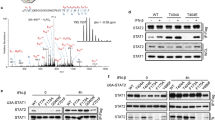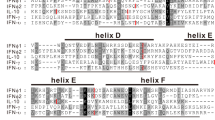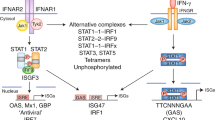Abstract
Interferons (IFNs) are a class of proteins, secreted by animal cells in response to various inducers1, which confer resistance to viral infections and are designated according to their cellular origin or to the inducing agent. Viruses induce type I Interferon, subdivided into α-interferon, produced by leukocytes (Le) or lymphoblastoid (Ly) cells, and β-interferon, produced by fibroblasts1. Mitogens and antigenic stimuli induce in lymphocytes type II immune IFN-γ. Interferons seem to bind to specific receptors2 to elicit a variety of cellular responses3; several early studies provided indirect evidence for such binding4–6. Direct evidence for specific interferon receptors was presented by Aguet7, who showed that biologically active 125I-labelled mouse (Mu)IFN binds to sensitive L1210-S cells, but not to interferon-resistant L1210-R cells8. The main obstacle in carrying out such studies is the availability of pure interferon. Recently, Maeda et al.9 constructed plasmids containing human interferon sequences. The plasmid p104 was used as a probe to isolate the coding region of a human interferon (IFLrA), which was expressed in Escherichia coli10 and purified with monoclonal antibodies11. This interferon, designated HuIFN-αA, was labelled with 125I for binding assays on human cells. We have determined the specificity of different HuIFNs for the cellular sites which bind HuIFN-αA and show here that HuIFN-γ does not compete for binding, whereas all type I HuIFNs do.
This is a preview of subscription content, access via your institution
Access options
Subscribe to this journal
Receive 51 print issues and online access
$199.00 per year
only $3.90 per issue
Buy this article
- Purchase on Springer Link
- Instant access to full article PDF
Prices may be subject to local taxes which are calculated during checkout
Similar content being viewed by others
References
Stewart, W. E. The Interferon System (Springer, New York, 1979).
Friedman, R. M. in Interferon Vol. 1 (ed. Gresser, I.) 53–72 (Academic, London, 1979).
Taylor-Papadimitriou, J. in Interferon Vol. 2 (ed. Gresser, I.) 13–46 (Academic, London, 1980).
Friedman, R. M. Science 156, 1760–1761 (1967).
Besançon, F. & Ankel, J. Nature 252, 478–480 (1974).
Berman, B. & Vilček, J. Virology 57, 378–386 (1974).
Aguet, M. Nature 284, 459–461 (1980).
Gresser, I., Bandu, M. T. & Brouty-Boye, D. J. Natn. Cancer Inst. 52, 553–559 (1974).
Maeda, S. et al. Proc. natn. Acad. Sci. U.S.A. 77, 7010–7013 (1980).
Goeddel, D. V. et al. Nature 287, 411–416 (1980).
Staehelin, T., Hobbs, D. S., Kung, H.-F., Lai, C.-Y. & Pestka, S. J. biol. Chem. (in the press).
Goeddel, D. V. et al. Nature 290, 20–26 (1981).
Herrup, K. & Shooter, E. M. Proc. natn. Acad. Sci. U.S.A. 70, 3884–3888 (1973).
Cuatrecasas, P. & Hollenberg, M. Adv. Protein Chem. 30, 251–451 (1976).
Cabrer, B. et al. J. biol. Chem. 254, 3681–3684 (1979).
Baglioni, C. & Maroney, P. A. Virology 101, 540–544 (1980).
Ankel, H. et al. Proc. natn. Acad. Sci. U.S.A. 77, 2528–2532 (1980).
Baglioni, C. & Maroney, P. J. biol. Chem. 255, 8390–8393 (1980).
Fleischmann, W. R. Jr, Georgiades, J., Osborne, L. C. & Johnson, H. M. Infect. Immunity 26, 248–253 (1979).
Bradshaw, R. A. A. Rev. Biochem. 47, 191–216 (1978).
Carpenter, G. & Cohen, S. A. Rev. Biochem. 48, 193–216 (1979).
Borden, E. C. & Leonhardt, P. H. J. Lab. clin. Med. 89, 1036–1042 (1977).
Laemmli, U. K. Nature 227, 680–685 (1970).
Yip, Y. K., Roy, H. L., Urban, C. & Vilčeck, J. J. Proc. natn. Acad. Sci. U.S.A. 78, 1601–1605 (1981).
Broeze, R. J. et al. J. Interferon Res. 1, 191–201 (1981).
Author information
Authors and Affiliations
Rights and permissions
About this article
Cite this article
Branca, A., Baglioni, C. Evidence that types I and II interferons have different receptors. Nature 294, 768–770 (1981). https://doi.org/10.1038/294768a0
Received:
Accepted:
Issue Date:
DOI: https://doi.org/10.1038/294768a0
This article is cited by
-
Changing the dosing schedule minimizes the disruptive effects of interferon on clock function
Nature Medicine (2001)
-
Interferon receptors
Biotherapy (1996)
Comments
By submitting a comment you agree to abide by our Terms and Community Guidelines. If you find something abusive or that does not comply with our terms or guidelines please flag it as inappropriate.



